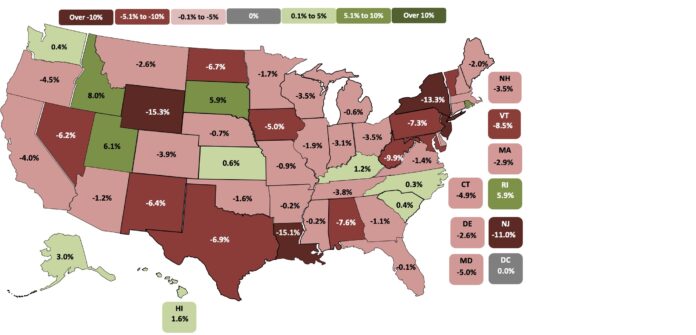California’s construction employment levels have, overall, declined only slightly during the COVID-19 pandemic, but there are great differences in some market areas, Associated General Contractors (AGC) of America reports in data compiled from government sources.
Overall the state’s construction employment (including mining and logging) declined by 4,600 or about 1 percent between February 2020 and June 2021.
But employment declined by 8 percent in San Francisco compared to a 3 percent decline in Los Angeles, compared to a 15 percent increase in the much smaller Redding market.
See the data by community below:
Numbers employed Feb. 2020; June 2021; change in past 16 months; percentage change in the past 16 months, national rank
- Statewide Construction 891,900 887,300 -4,600 -1%
- Statewide Mining, Logging, and Construction 913,500 906,200 -7,300 -1%
- Anaheim-Santa Ana-Irvine Div. Construction 106,600 103,600 -3,000 -3% 301
- Bakersfield Construction 16,200 14,600 -1,600 -10% 337
- Chico Mining, Logging, and Construction 4,400 4,100 -300 -7% 325
- El Centro Mining, Logging, and Construction 2,000 1,800 -200 -10% 337
- Fresno Construction 19,200 20,800 1,600 8% 154
- Hanford-Corcoran Mining, Logging, and Construction 900 1,000 100 11% 107
- Los Angeles-Long Beach-Glendale Div. Construction 153,400 148,500 -4,900 -3% 301
- Madera Mining, Logging, and Construction 2,000 2,000 0 0% 258
- Merced Mining, Logging, and Construction 2,700 2,800 100 4% 213
- Modesto Mining, Logging, and Construction 10,100 10,700 600 6% 183
- Napa Mining, Logging, and Construction 4,400 4,600 200 5% 197
- Oakland-Hayward-Berkeley Div. Construction 75,400 75,200 -200 0% 279
- Oxnard-Thousand Oaks-Ventura Construction 17,200 16,600 -600 -3% 301
- Redding Mining, Logging, and Construction 4,000 4,600 600 15% 73
- Riverside-San Bernardino-Ontario Construction 108,900 108,300 -600 -1% 281
- Sacramento–Roseville–Arden-Arcade, CA Construction 70,600 78,100 7,500 11% 107
Salinas Construction 6,600 6,800 200 3% 223 - San Diego-Carlsbad Construction 84,000 84,100 100 0% 257
- San Francisco-Redwood City-South San Francisco Div.Construction 46,400 42,900 -3,500 -8% 329
- San Jose-Sunnyvale-Santa Clara Construction 53,200 50,200 -3,000 -6% 321
- San Luis Obispo-Paso Robles-Arroyo Grande Mining, Logging, and Construction 8,500 8,500 0 0% 258
- San Rafael Div. Construction 7,600 7,700 100 1% 245
- Santa Cruz-Watsonville Mining, Logging, and Construction 4,600 4,500 -100 -2% 289
- Santa Maria-Santa Barbara Construction 9,100 8,900 -200 -2% 289
- Santa Rosa Construction 16,700 16,400 -300 -2% 289
- Stockton-Lodi Construction 13,300 13,700 400 3% 223
- Vallejo-Fairfield Construction 11,900 10,900 -1,000 -8% 329
- Visalia-Porterville Mining, Logging, and Construction 6,500 6,800 300 5% 197
- Yuba City Mining, Logging, and Construction 2,800 2,800 0 0% 258
Nationally, construction employment declined or stagnated in 101 metro areas between February 2020, AGC reported in its July 28 analysis.
Association officials said that labor shortages and supply chain problems were keeping many firms from adding workers in many parts of the country.
“Typically, construction employment increases between February and June in all but 30 metro areas,” said Ken Simonson, the association’s chief economist. “The fact that more than three times as many metros as usual failed to add construction jobs, despite a hot housing market, is an indication of the continuing impact of the pandemic on both demand for nonresidential projects and the supply of workers.”
Eighty metro areas had lower construction employment in June 2021 than February 2020, while industry employment was unchanged in 21 areas. Houston-The Woodlands-Sugar Land, Texas lost the most jobs: 33,400 or 14 percent. Major losses also occurred in New York City (-22,000 jobs, -14 percent); Midland, Texas (-9,300 jobs, -24 percent); Odessa, Texas (-7,900 jobs, -38 percent) and Baton Rouge, La. (-7,700 jobs, -16 percent). Odessa had the largest percentage decline, followed by Lake Charles, La. (-34 percent, -6,700 jobs); Laredo, Texas (-25 percent, -1,000 jobs); Midland; and Longview, Texas (-22 percent, -3,300 jobs).
Of the 257 metro areas—72 percent—added construction jobs over the February 2020 level, Chicago-Naperville-Arlington Heights, IL. added the most construction jobs over 16 months (14,300 jobs, 12 percent), followed by Minneapolis-St. Paul-Bloomington, Minn.-Wis. (13,800 jobs, 18 percent); Indianapolis-Carmel-Anderson, Ind. (10,700 jobs, 20 percent); Warren-Troy-Farmington Hills, Mich. (9,300 jobs, 18 percent); and Pittsburgh, Pa. (7,600 jobs, 13 percent). Fargo, N.D.-Minn. had the highest percentage increase (50 percent, 3,700 jobs), followed by Sierra Vista-Douglas, Ariz. (48 percent, 1,200 jobs); Bay City, Mich. (45 percent, 500 jobs); St. Cloud, Minn. (39 percent, 2,400 jobs) and Kankakee, Ill. (36 percent, 400 jobs).
Association officials urged Congress and the Biden administration to make new investments in workforce development and to take steps to address supply chain issues. “They called for additional funding for career and technical education; they noted that craft training receives only one-sixth as much federal funding as college preparation.” They also continued to call on the president to remove tariffs on key construction materials like steel and aluminum.
“Federal officials may talk about the value of craft careers like construction, but they are failing to put their money where their mouth is,” said Stephen E. Sandherr, the association’s chief executive officer. “Until we expose more people to construction careers, and get a handle on soaring materials prices, the construction industry is likely to have a hard time recovering from the pandemic.”














